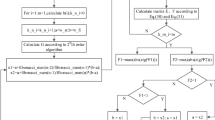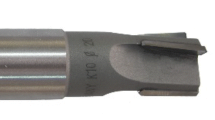Abstract
The modelling of the dynamic processes in milling and the determination of chatter-free cutting conditions are becoming increasingly important in order to facilitate the effective planning of machining operations. In this study, a new chatter stability criterion is proposed, which can be used for a time domain milling process simulation and a model-based milling process control. A predictive time domain model is presented for the simulation and analysis of the dynamic cutting process and chatter in milling. The instantaneous undeformed chip thickness is modelled to include the dynamic modulations caused by the tool vibrations so that the dynamic regeneration effect is taken into account. The cutting force is determined by using a predictive machining theory. A numerical method is employed to solve the differential equations governing the dynamics of the milling system. The work proposes that the ratio of the predicted maximum dynamic cutting force to the predicted maximum static cutting force can be used as a criterion for the chatter stability. Comparisons between the simulation and experimental results are given to verify the new model.








Similar content being viewed by others
References
Tobias SA (1965) Machine tool vibration. Blackie and Sons, London
Koenigsberger F, Tlusty J (1967) Machine tool structures—vol. 1: stability against chatter. Pergamon Press, Oxford, UK
Merritt HE (1965) Theory of self-excited machine-tool chatter, contribution to machine-tool chatter research-1. ASME J Engin Indust 87:446–454
Sridhar R, Hohn RE, Long GW (1968) A general formulation of the milling process equation. ASME J. Engin Indust 90:317–324
Opitz H, Bernardi F (1970) Investigation and calculation of the chatter behavior of lathes and milling machines. Annals CIRP 18:335–343
Minis I, Yanushevsky R, Tembo A (1990) Analysis of linear and nonlinear chatter in milling. Annals CIRP 39(1):459–462
R. Minis I, Yanushevsky R (1993) A new theoretical approach for the prediction of machine tool chatter in milling. ASME J Engin Indust 115:1–8
Shi HM, Tobias SA (1984) Theory of finite amplitude machine tool instability. Int J Mach Tool Des Res 24(1):45–69
Budak E, Altintas Y (1995) Analytical prediction of chatter stability in milling, part 1: general formulation. In: Proceedings of the ASME Dynamic Systems and Control Division, Dsc-Vol. 57(1):545–556
Altintas Y, Budak E (1995) Analytical prediction of stability lobes in milling. Annals CIRP 44(1):357–362
Altintas Y (2000) Modeling approaches and software for predicting the performance of milling operations at MAL-UBC. In: Proceedings of the CIRP 2000 Machining Workshop, University of New South Wales, Sydney, Australia, August 2000
Tlusty J, Ismail F (1981) Basic nonlinearity in machine chatter. Annals CIRP 30:21–25
Tlusty J, Ismail F (1983) Special aspects of chatter in milling. ASME J Engin Indust 105:24–32
Smith S, Tlusty J (1993) Efficient simulation programs for chatter in milling. Annals CIRP 42(1):463–466
Tlusty J (1986) Dynamics of high-speed milling. ASME J Engin Indust 118:59–67
Smith S, Tlusty J (1990) Update on high-speed milling dynamics. ASME J Engin Indust 112:142–149
Lee AC, Liu CS, Chiang ST (1991) Analysis of chatter vibration in a cutter-workpiece system. Int J Mach Tools Manufact 31(2):221–234
Altintas Y, Spence A (1991) End milling force algorithms for CAD systems. Annals CIRP 40(1):31–34
Oxley PLB (1989) The mechanics of machining: an analytical approach to assessing machinability. Ellis Harwood Ltd., London
Tlusty J (1994) Automatic supervision in milling. In: Szafarczyk M (ed) Automatic supervision in manufacturing. Springer, London pp 35–65
Li HZ, Li XP (2000) Modelling and simulation of chatter in milling using a predictive force model. Int J Mach Tools Manufact 40(14):2047–2071
Li HZ, Zhang WB, Li XP (2001) Modelling of cutting forces in helical end milling using a predictive machining theory. Int J Mechan Sci 43(8):1711–1730
Tlusty J (1986) Dynamics of high-speed milling. ASME J Engin Indust 118:59–67
Author information
Authors and Affiliations
Corresponding author
Rights and permissions
About this article
Cite this article
Li, H.Z., Li, X.P. & Chen, X.Q. A novel chatter stability criterion for the modelling and simulation of the dynamic milling process in the time domain. Int J Adv Manuf Technol 22, 619–625 (2003). https://doi.org/10.1007/s00170-003-1562-9
Received:
Accepted:
Published:
Issue Date:
DOI: https://doi.org/10.1007/s00170-003-1562-9




